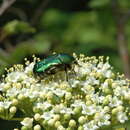Biology
provided by Arkive
The adult beetles are active between April and September; they fly clumsily (2) and are typically seen in sunny weather. They feed on leaves, fruits, flowers and buds of a range of plants including roses, (hence the common name), and are often perceived as garden pests for this reason (3).
The larvae feed on plant roots, and spend the winter hibernating in the soil or inside rotting wood, emerging the following year to pupate. After they emerge as adults they feed for a few weeks, mate and then die (3).
Conservation
provided by Arkive
Conservation action is not required for this species.
Description
provided by Arkive
This beautiful iridescent beetle can occur in a variety of colours; the wingcases or elytra are typically bright green, but they may be darker, variegated or golden. The white marks on the elytra are also highly variable between individuals (2). There is always a V-shaped groove on the back where the upper parts of the elytra meet, and the underside is a coppery colour (3). The rose chafer belongs to the same family as dung beetles, Scarabidae. Chafer is a Middle English word thought to mean 'to gnaw' and relates to the feeding habits of these beetles (4).
Habitat
provided by Arkive
The adults of this species are commonly found in gardens, sitting in flowers. The larvae live inside rotting wood and humus (2).
Range
provided by Arkive
This common species is found throughout much of southern and central Europe (3), but becomes more scarce further north (2).
Status
provided by Arkive
Not threatened in Britain (2).
Threats
provided by Arkive
This species is not currently threatened in Britain.

